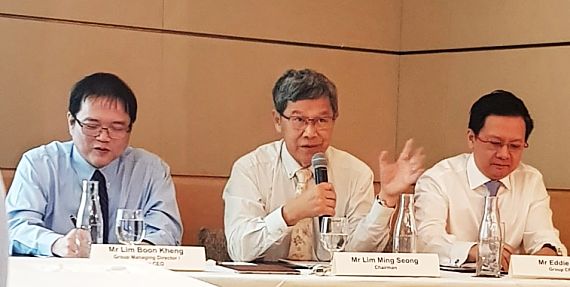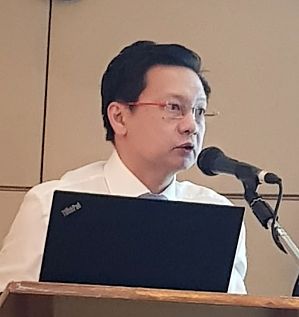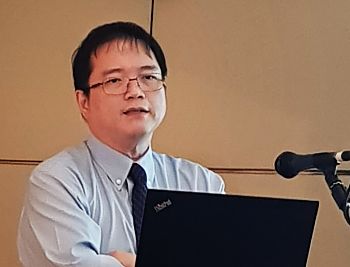| CSE Global's Powerpoint presentation material and related statements offer an abundance of content on its 2018 business performance. Management filled in more details at a results briefing last week.  L-R: MD Lim Boon Kheng | Chairman Lim Ming Seong | CFO Eddie Foo. NextInsight photo. L-R: MD Lim Boon Kheng | Chairman Lim Ming Seong | CFO Eddie Foo. NextInsight photo.This is how I (not entirely familiar with the company) deconstruct the story. (Experts can jump straight to UOB Kay Hian's analyst report here). |
1) Steady quarterly revenue: In 2018, CSE Global's revenue recognition was consistent from quarter to quarter, suggesting a high degree of stability in its business.
The silky smooth quarterly transition was accompanied by a stable order intake -- until 4Q when it spiked up:
|
|
Q1 2018 |
Q2 2018 |
Q3 2018 |
Q4 2018 |
|
Revenue |
$92.2 m |
$92.1 m |
$92.4 m |
$100.1 m |
|
Order intake |
$69.0 m |
$89.1 m |
$80.9 m |
$145.2 m |
CSE says new orders received for FY2018 were mainly from higher order wins for large infrastructure projects in the Asia Pacific region as well as higher flow orders from greenfield (new installations) and brownfield (maintenance, upgrade and enhancement of existing installations) in Americas and Australia.
For what "infrastructure" projects mean, see: CSE GLOBAL: What is "infrastructure" business, why it spells growth?
The sharp jump in order intake in 4Q made up for a comparatively slow intake in 1Q.
|
Stock price |
47 c |
|
52-week |
35-52 c |
|
PE (ttm) |
12 |
|
Market cap |
S$239 m |
|
Shares outstanding |
509 m |
|
Dividend |
5.85% |
|
1-year return |
30% |
|
Source: Bloomberg |
|
2) Steady orderbook: As at end-2018, the outstading orderbook amounted to $181.0 million, which is similar to the $175.0 million as at end-2017. That's yet another sign of stability.
3) Net profit jump: Where 2018 was different from 2017 was in the profitability: Net profit was $20.1 million versus $13.3 million (before exceptional items) despite 2018 revenue being up only 4% ($376.8 million). CFO Eddie Foo. NextInsight photo It follows that the 2018 gross margin improved (from 26.0% to $27.9%) as did the net margin (from 3.7% to 5.3%).
CFO Eddie Foo. NextInsight photo It follows that the 2018 gross margin improved (from 26.0% to $27.9%) as did the net margin (from 3.7% to 5.3%).
4) Big cashflow: What was also nice was the operating cashflow, which amounted to $56.3 millon (a far cry from the operating outflow of $1.6 million in 2017 due to working capital needs for large projects).
The operating cashflow in 2018 exceeded the net profit and was due to "better working capital management," according to management.
As a result, CSE Global's net cash rose to $37.9 million as at end-2018 from $15.5 million a year earlier.
|
CSE GLOBAL |
|
|
Share price: |
Target: |
|
Source: UOB Kay Hian |
|
5) Unchanged dividend: CSE has proposed a final dividend of 1.5 cents a share, bringing the total for the year to 2.75 cents.
No surprises again, as 2.75 cents a share was what shareholders have received for each of the prior four years (FY2014 - 2017).
Positive future: "Price war is over" Managing Director Lim Boon Kheng. Managing Director Lim Boon Kheng. NextInsight photo • Management has guided for gross margin to stay stable at 27% this year. They would know, based on the contracts on hand. • One of the "greenfield infrastructure" contracts, secured in Dec 2018, was a large one awarded by the Singapore government and involved high security, so scant information on it will ever be publicised.
Thus, meaningful revenue contribution will start from 2H2019 and spread over a few years, including that from maintenance work. There's a pipeline of Singapore government contracts which CSE will bid for selectively. CSE is relatively small versus government-linked competitors such as ST Engineering but the historical links arising from CSE being a spinoff from Singapore Technologies are not lost on some share investors. • Be it in the oil & gas segment in the US or infrastructure segment in Singapore and Australia, CSE anticipates bids for work will likely be "stable", unlike the "price war" that was widespread in the years following the oil crash in 2014. • In pursuit of growth, and to widen its geographic reach and skillsets, CSE is evaluating several M&A possibilities, with an eye on earnings accretion. The M&A intention is why CSE's short-term borrowings rose from $31.4 m (as at end-2017) to $36.1 m (as at end-2018). |





